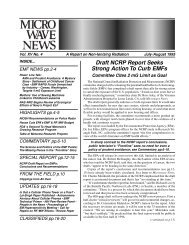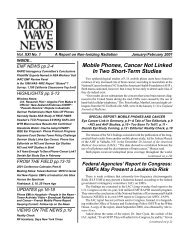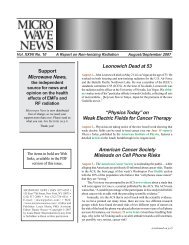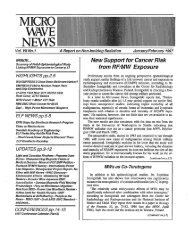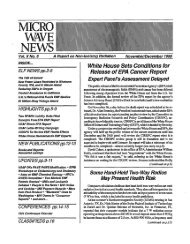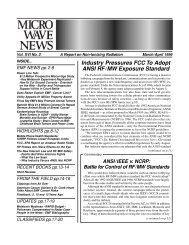Microwave News - November/December 1985
Microwave News - November/December 1985
Microwave News - November/December 1985
Create successful ePaper yourself
Turn your PDF publications into a flip-book with our unique Google optimized e-Paper software.
UPDATES BIOLOGICAL EFFECTS<br />
Bluorescent Lights and Skin Caneer...A team of Austra-<br />
lian researchers has failed to confirm a previous report of<br />
an association between exposure to fluorescent lighting and<br />
malignant melanoma. The new case-control study did find<br />
some suggestion of increased risk for certain types of skin<br />
cancer, hut did not agree with the doubling of all<br />
melanomas reported in 1982. The 1982 paper, the fust to<br />
report a link between exposure to fluorescent lights and<br />
skin cancer, did not win widespread acceptance because of<br />
a number of curious findings: while fluorescent lights at<br />
work were linked with melanoma, those at home were not;<br />
and the association was greatest for those patts of the body<br />
that are usually covered by clothing (see MWN, Sep-<br />
tember 1982). The new study, by Dr. D.R. English and<br />
coworkers at the University of Westem Australia, did find<br />
evidence of an increase in Hutchison's melanotic freckles<br />
on the head, neck and upper limbs with exposure to<br />
fluorescent lights without diisers in residential moms and<br />
small offices, and of an increase in the rate of "melanoma<br />
of unclassifiable histogenic type" with fluorescent light<br />
exposure. But the researchers suggested that these may<br />
have occurred due to chance. They concluded: "Our re-<br />
sults are consistent with the view that the dose of UV radi-<br />
ation received from fluorescent lights is too small in com-<br />
parison with that &om the sun at least in Western Australia<br />
to have a measurable additional effect on risk of<br />
melanoma. " The new study, "Cutaneous Malignant<br />
Melanoma and Fluorescent Lighting," appeared in the<br />
Jone <strong>1985</strong> Journal of the National Cancer Institute.<br />
Delgado References ...In our <strong>December</strong> 1984 issue, we re-<br />
ported a correction in the rise times of the magnetic field<br />
pulses used by members of Dr. Jose Delgado's research<br />
team in Madrid, Spain. The official correction was pub-<br />
lished in the Journal of Anatomy, 140, p.721, <strong>1985</strong> .... A<br />
paper describing the failure to fid an effect of weak low<br />
frequency electromagnetic fields on chick embryos by Dr.<br />
Morton Miller and associates at the University of Roches-<br />
ter appeared in the Joitrtzal of Anatomy, 139, pp.613-618,<br />
1984. As noted in our Jone 1984 cover story, this experi-<br />
ment was substantially different from those of Delgado and<br />
Dr. Jocelyne Leal, which yielded positive resul ts.... In Sep-<br />
tember 1984, EPA's Richard Tell and Dr. Ezra Berman vis-<br />
ited Delgado and Leal in Spain. A report on their visit is<br />
now available from Tell, Electromagnetics Branch, Office<br />
of Radiation Programs, EPA, PO Box 18416, Las Vegas,<br />
NV 89114, (702) 798-2440.<br />
Static Magnetic FieIds...Male workers exposed to static<br />
magnetic fields in a chloralkali plant had a normal rate of<br />
ckncer and life expectancy, according to a Swedish sludy<br />
published in the October 19 issue of Lancet. Men who had<br />
worked in the plant at least a year were included in the<br />
study population. Dr. Lars Bmgard and coworkers at the<br />
Department of Occupational Medicine at Sahlgren Hospital<br />
in Goteborg measured the magnetic fields in the plant to be<br />
between 4 and 29 millitesla. They noted that even though<br />
the fields in the plant were static, currents can be induced<br />
in the workers as they move around. They concluded:<br />
'The cohort studied was small but the confidence limits<br />
indicate that there is at least no greatly increased risk of<br />
cancer after many years of exposure to strong static mag-<br />
netic fields." ... In France, Dr. A. Bellossi has found that<br />
static magnetic fields of 300-800 millitesla had no effect<br />
on the growth and development of chemically-induced<br />
NmOtS in mice. See "The Effect of a Static Uniform Mag-<br />
netic Field on Mice: A Study of Methylcholanthren Car-<br />
cinogenesis," Radiation and ~nvironmental Biophysics,<br />
23, pp.107-109, 1984.<br />
Behavioral Effec ts...The FDA's Center for Devices and<br />
Radiological Health (CDRH) has published the proceed-<br />
ings of a workshop on the effects of microwave radiation<br />
on behavior, held in Midway, UT, in March 1982. Behav-<br />
ioral Effects of <strong>Microwave</strong> Radiation Absorption was<br />
edited by the CDRH's Dr. John Monahan and Dr. John<br />
D'Andrea, who used to be at the University of Utah and is<br />
now with the Naval Aerospace Medical Research Labora-<br />
tory in Pensacola, FL. Among the 14 papers presented at<br />
the workshop was one by Dr. Clifford Mitchell of NIEHS<br />
on "Soviet Research on <strong>Microwave</strong>-Behavior Interac-<br />
tions." A limited number of copies are available for free<br />
by writing to CDRH, FDA (-265). 5600 Fishers Lane,<br />
Rockville, MD 20857. Ask for publication No. FDA 85-<br />
8238 and include a self-addressed mailiig label.<br />
COMPATIBILITY & INTERFERENCE<br />
Pesty Pest Control ... Ultrasonic pest control devices can<br />
cause RFI to TV reception and other types of electronic<br />
equipment, according to the FCC - RFl has been reported<br />
in the 20-470 MHz frequency range. The devices drive<br />
away rats, mice and roaches with noise that is inaudible to<br />
humans. Fortunately, FCC staffers have found that the of-<br />
fending interference can be substantially reduced by mak-<br />
ing a minor change to the device. For more information,<br />
contact Joe Husnay, FCC Laboratory, (301) 725-1585.<br />
Resources ..." Taming EM1 in Micropmcessor Systems"<br />
by Don White, Kenn Atkinson and John Osbum of Inter-<br />
ference Controt Technologies, Iuc., in Gainesville, VA, is<br />
the lead story in the <strong>December</strong> issue of IEEE Spectrum. In<br />
their well-illustrated article, the authors propose a system-<br />
atic approach for dealing with EM1 effects. They begin<br />
with a blood-chiUig example of the dangers of EMI: A<br />
ladle of molten steel, moving along an overhead track at a<br />
plant in the eastern U.S. in 1983, prematurely poured the<br />
hot metal onto the factory floor, killing one worker and<br />
injuring four others. The cause of the accident was traced<br />
to a walkie-talkie. The RF signal -magnified by a tem-<br />
porary scdf'old and picked up by a drop cord acting as an<br />
antenna - triggered a switch that caused the ladle to<br />
tip .... In past issues, we have featured items on EPRI and<br />
IITRI research on the susceptibility of railroad signaling<br />
equipment to power line interference (see MWN, Sep-<br />
tember and <strong>December</strong> 1983 and April <strong>1985</strong>). Two papers<br />
from this effort appear in the <strong>December</strong> issue of IEEE<br />
MICROWAVE NEWS NovernaPlDccc~i~ber <strong>1985</strong>



